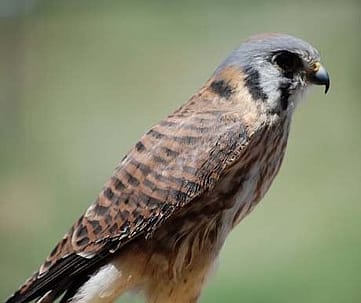
Thank you to all who entered the contest to name our new American Kestrel
Our Draper Museum Raptor Experience has a new member of the flock!

Our newest raptor is a young, female American kestrel. She hatched earlier this year and was most likely just getting the hang of flying when she collided with something (we’ll never know what), causing permanent damage near her left elbow.
She was found at a construction site in the West Valley City area of Salt Lake and taken to Second Chance Wildlife Rehabilitation in Price, Utah. Unfortunately, she will never be able to fly properly and so must rely on human care to survive.
She now has a permanent home with our Draper Museum Raptor Experience, bringing our flock of non-releasable birds up to 12 members who present educational programs—both in person and virtually—year-round.
We conducted a naming contest (which ended at midnight on Sunday, October 18, 2020) for this beautiful girl…
And the winning name is: Freyja
Our female kestrel has a name!!!! After a week of name submissions from the public, the name, Freyja, was chosen for our newest bird.
Freyja is one of the most popular of the Norse gods. She was the goddess of fertility, luck, love, and protection. As the submitter of the winning name states, “Freyja is a perfect match for the young female kestrel. She’s embarking new life into the program, not just for kestrels but for all the birds. Her youth means she will be around for many years – blessing all who encounter her at the Draper Museum Raptor Experience.”
Freyja is still in training to become one of our ambassadors and there is no way to know exactly when she will make her first public appearance. Like all animals, she is an individual and each individual learns at their own pace. Because of her small stature and role as a prey item to many other predators, we will take our time to ensure that she is comfortable in every step of her training so that will continue in every aspect of her life.
About American Kestrels
- American kestrels are the smallest, most widespread, and most common falcon species in North America.
- They are incredibly beneficial birds, eating small rodents, birds, and various insects throughout the open spaces of meadows, fields, and grasslands of the United States.
- Typically, they only live around five years in the wild, but in captivity they can live three times that long.
- They are one of the few raptor species in which the males and females show physical differences. Similar to songbirds and waterfowl, male kestrels are more colorful. Our other American kestrel, Salem, is male, so we can compare their coloring. Learn more about our two kestrels.
- American kestrel populations have been steadily declining since the mid-1960s. Although they are not considered threatened or endangered yet, it is estimated that their population has dropped more than 50 percent over the last 50 years. Research is being conducted to determine the reason for the decline, but it is believed to be due to clearing of land, particularly trees along the edges of open areas where kestrels hunt. These trees are critical because they provide cavities for nesting. American Kestrels have also been impacted by the use of pesticides and other pollutants.
The Draper Museum Raptor Experience is funded in part by the Nancy-Carroll Draper Foundation, the W.H. Donner Foundation, and the Donner Canadian Foundation—the latter in partnership with the University of Wyoming’s Biodiversity Institute.
Our Adopt-a-Raptor program welcomes people to assist us in the care and feeding of our birds. Find out how to participate!
Written By
Nancy McClure
Nancy now does Grants & Foundations Relations for the Center of the West's Development Department, but was formerly the Content Producer for the Center's Public Relations Department, where her work included writing and updating website content, publicizing events, copy editing, working with images, and producing the e-newsletter Western Wire. Her current job is seeking and applying for funding from government grants and private foundations. In her spare time, Nancy enjoys photography, reading, flower gardening, and playing the flute.








